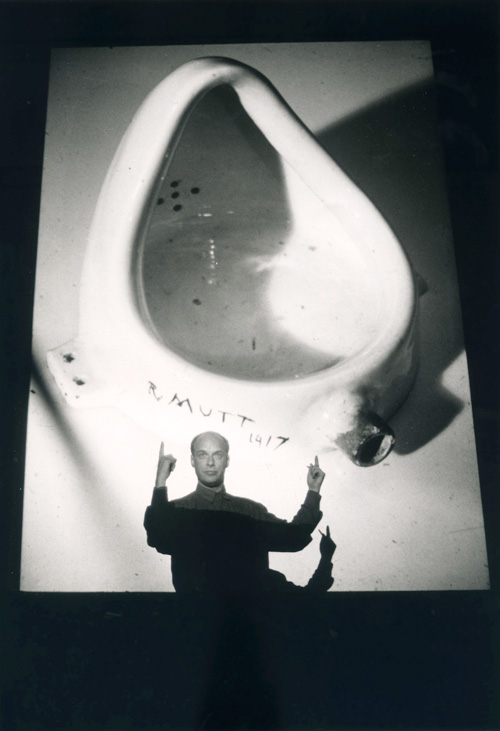
The NY Times Magazine’s interview with Brian Eno brings back his story about pissing in Marcel Duchamp’s Fountain. It’s a story Eno’s told many times. Every time it gets retold, there’s an air of incredulity; because it sounds fake as hell.
The clearest, widely available version of the story has been from when he told it to designer Ron Arad in 1993. That’s on YouTube [at around 17 minutes]. He was specifically, asked: “Have you really used the Fountain?” Eno laughs. “Yes, yes, that was a really good story.” He then mis-tells the history of Fountain, and Duchamp’s concept of Readymades, and misses the point that Fountain is not one ancient, auratic urinal, but is actually an edition of eight, plus several others.

And he said, “So I thought someone should piss in that thing, to sort of bring it back to where it belonged. So I decided it had to be me.” He then says the strength and aim of his urine stream were, “at [his] age,” insufficient to get through the narrow gap in the glass. So he got thin, plastic tubing, threaded it with wire, pipetted his piss into it, put it in his pants, and then he inserted it through a gap, “and let the piss out. It’s a bit of a fake, really. I didn’t physically do it.” Which, in context, could sound like he’s saying he didn’t physically piss in Fountain. But it could also be an admission that the events in this “story” only happened in his head. Which should be the same in conceptual art, no? Eno then claimed he only revealed what he’d done at his lecture “that night,” at the Museum of Modern Art.
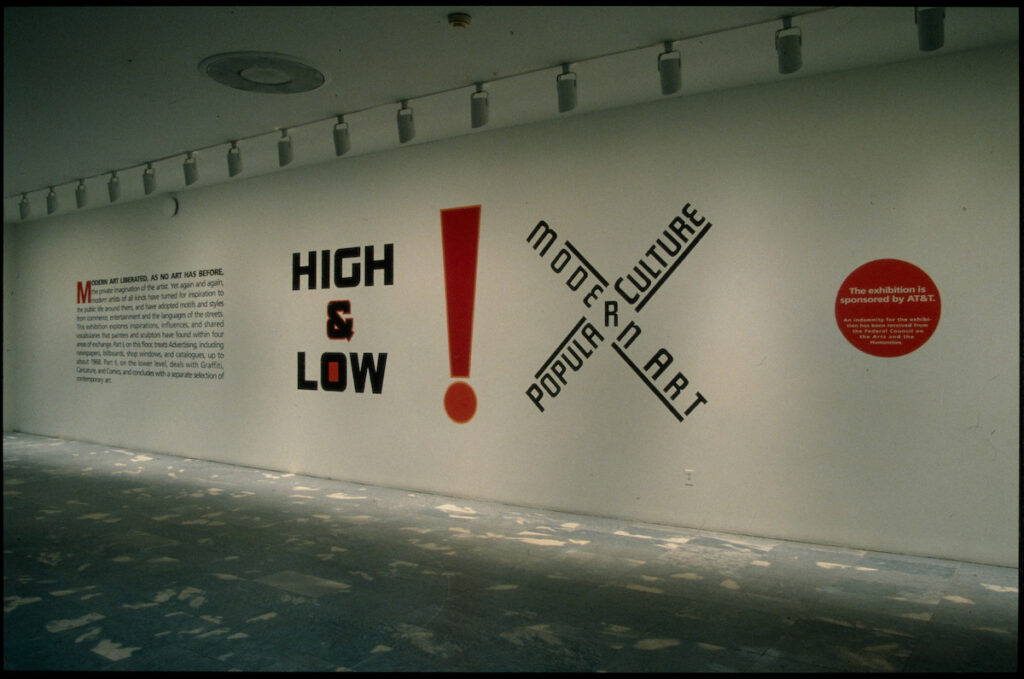
Which means this either did or did not happen on October 23, 1990, when Eno spoke as part of a performance art [sic] series organized by RoseLee Goldberg for “High & Low: Modern Art and Popular Culture,” a sprawling show curated by Kirk Varnedoe and Adam Gopnik. The Modern borrowed an edition of Fountain–which is does not own–and showed it in a wall case between Duchamp’s Bicycle Wheel–which it does own–and Brancusi’s Cup II, from the Pompidou.
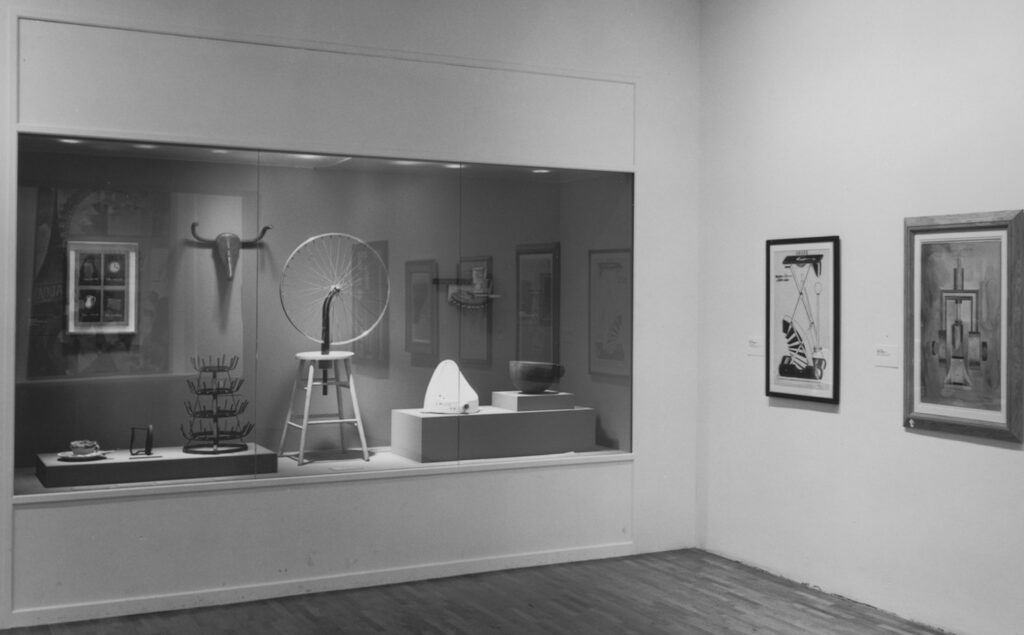
The checklist is not published, but from photos, I think this Fountain was the Janis’s, which was acquired by the Philadelphia Museum in 1998. It’s the oldest replica of Fountain–Duchamp authorized Sidney Janis to make it for a 1951 show at his gallery. According to Francis Naumann, Janis found it in a Paris junk shop. A longtime MoMA trustee, Janis also made the Bicycle Wheel, now in the museum, for the same show.
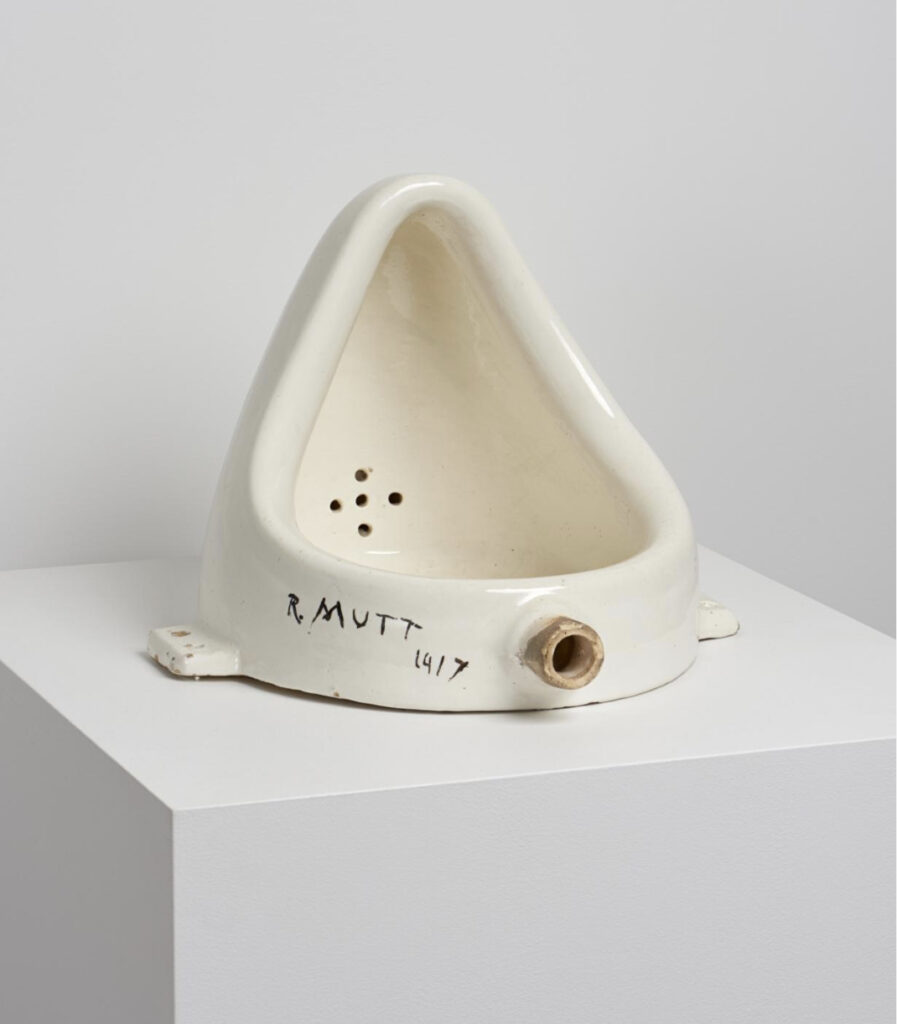
So in addition to being local and readily available, this Fountain was at once the “original” and made–yet not made, found–by someone else. Duchamp told Janis his installation of Fountain, low to the ground and in the corner, was, ideal for use by “little boys.” At the time, Brian Eno was three years old. Duchamp saw him coming.
So how did this all go down? Except for the photo up top, I haven’t seen any actual account or information from Eno’s lecture. Fortunately, an audio recording was released by WPS1, aka Art on Air, aka Clocktower Radio, aka Clocktower, the online radio channel launched by Alanna Heiss. Unfortunately, the webplayer doesn’t work, so until I can upload it myself, I’m hotlinking to the mp3 or here is the 12:47 part about the pissing. [Maybe MoMA can use some of its new-found Paley digitizing money to host more of its own archival content?]
Even for a show about the collapsing and intermingling of fine art and popular culture, Eno’s talk was largely focused on gatekeeping and money. He talked about encountering Fountain in multiple places over the years, not as seeing multiple editions of a work, but as if this one, overpriced art toilet had been following him around, racking up massive shipping & insurance charges.
“Having seen that piece three times now, in three different places, geographically very far apart, I thought maybe it was time to reinstate the urinal’s place in the real world. So I read some art magazines, and I heard about this thing called ‘commodification,’ and I thought I would try to do a performance, actually, here. And this was going to be my performance. So, the first picture: [Rustling sound of what I think is Eno changing transparencies on an honest-to-goodness overhead projector, followed by laughter from the audience.] Here’s another one. Here’s a side view. [Roaring laughter.]
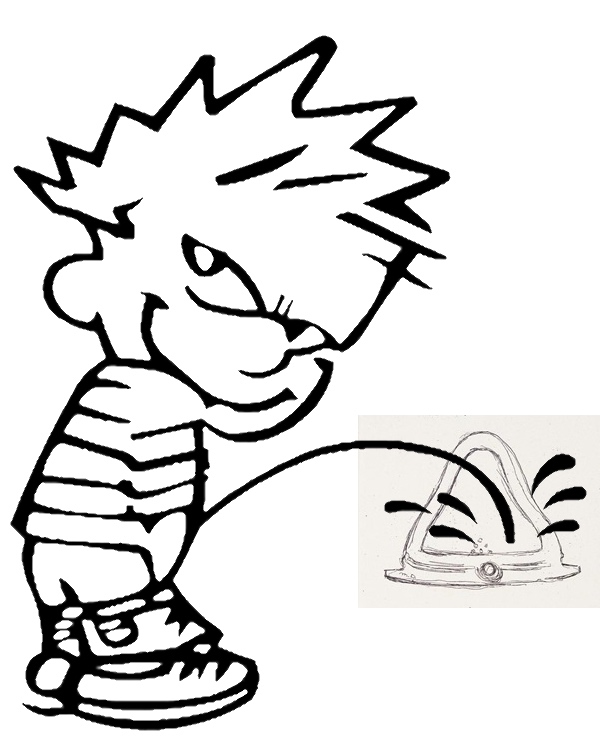
“You need this kind of thing if you’re making grant applications.” [Rustling, laughter, breaking into applause. And another one. And another one.]
“So I was all set up to do this, and I arrived at the museum expecting this thing to be stuck on a wall, so that I could execute this performance. But unfortunately, it was behind sheets of glass. So I’m very disappointed to say I couldn’t do that.
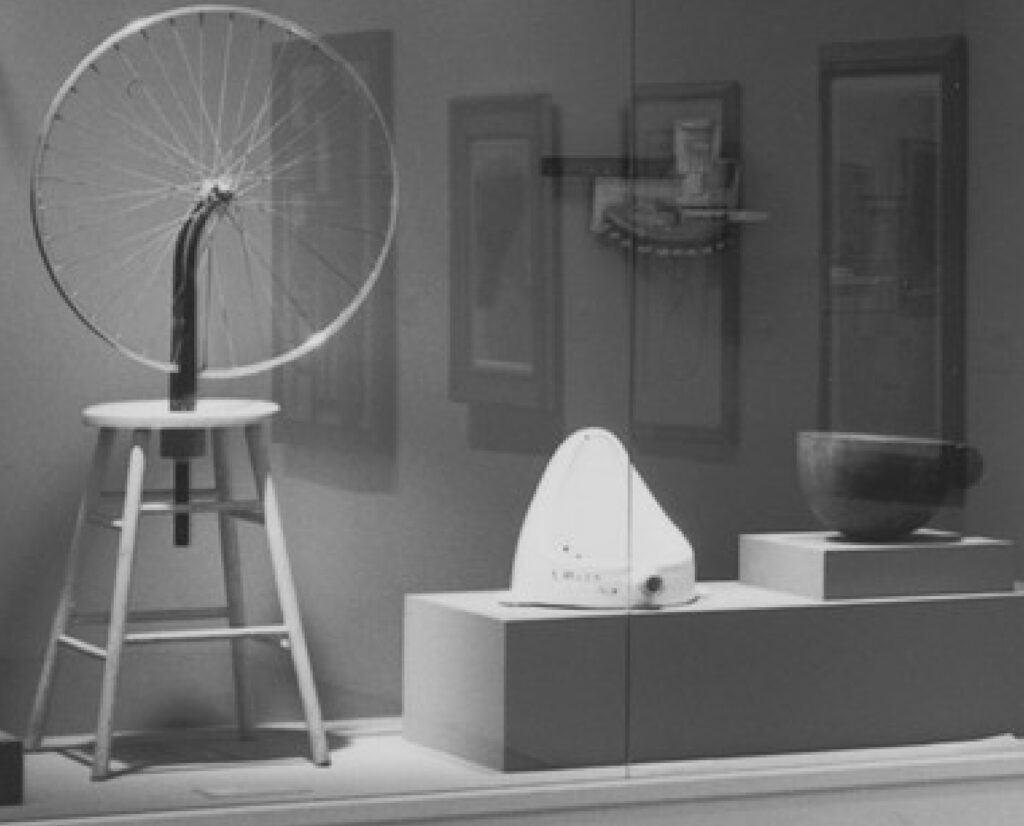
“However, I did notice, on inspecting the sheets of glass quite carefully, that they didn’t quite meet. There was a small crack between them. It was about 3/16 of an inch wide. So I thought, ‘I wonder if I could slide a small pipette through there [Rustling of transparencies, presumably with a diagram of his idea, laughter] containing some of my urine? [laughter] And. That’s what I did. [laughter].”
“There’s the pipette, can you see it? It’s a piece of plastic tube stiffened with a piece of wire. Available from any hardware store. And uh, [rustling] I thought, actually, that this would be an act of decommodification, but I realized, of course, it’s an act. of. this: [presenting a transparency that says “Re-Commode-ification.” laughter, including him laughing at his own joke.] So the result of all this, I’m sure, is that [presents punchline transparency to much laughter] It was only a few millileters, I don’t think it will void the insurance, or anything like that.”
“Anyway, this action of mine raises some very important questions, I think.” Indeed. “How much is my piss worth? Is it as valuable as Andy Warhol’s? Is it as valuable as Andre Serrano’s? I don’t think it is, actually, but it might become now as a result of this act. Does this act enrich or erode the piece? Depends what I’ve been eating, I guess. Does the act of returning it to its actual usage make it a more valuable work? If so, what do I get? [Laughter and applause, presumably at the projection of a sight joke.] Will I be eligible now for any grants? Now these questions I’ll leave hanging for a moment, but I’ll just make a few remarks to conclude this historic moment, in the history of art. That is actually my mark on art history; that is probably the only mark I’ll leave on art history. It hasn’t made much of a mark, perhaps you can see it if you look carefully.”
Eno’s performative philistinism could have ended that Tuesday night; the Modern was closed the next day, so if he had indeed left his mark on the late trustee’s sculpture, a conservator would have wiped it away without a trace. I still think the real question remaining is, did it really happen? Also, does it matter?
Eno went on to talk even more about money, both as a differentiator between high and low art, but also how money, like art, is an entirely arbitrary confidence game where value is determined based solely on mutual delusions of trust. His story, his claim, was a provocation, not because it questioned the status of an art object–which, let’s be clear, was an actual, found, used toilet–but because it challenges the integrity of the art institution. MoMA is to art what the Federal Reserve is to money. Eno’s claim undermines the museum’s integrity, not by casting doubt, not on their critical power, but on their ability to preserve an object in their care.
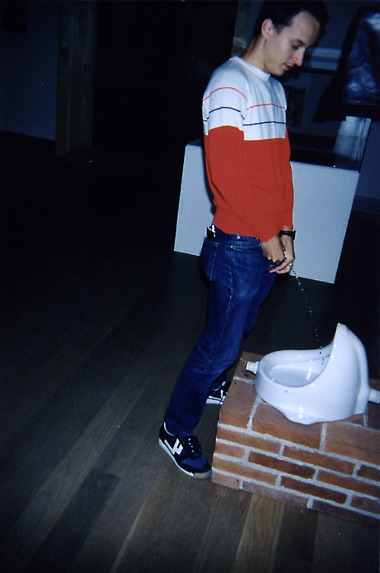
Eno has repeated this story over the years, without ever seeming to correct the inaccuracies of his original presumptions, or to expand his view of Duchamp’s project. All the while, more pissers have lined up to take their own shot at Duchamp, achieving nothing that Duchamp himself didn’t predict, and generating little more than exposure. But he’s still at it this week, as crypto convulsions and climate crisis protestors threaten some of the basic foundations of the shared delusions of trust we call society.
I think we need to hear what happened from someone besides Brian Eno. Kirk Varnedoe is dead, so we can’t ask him. RoseLee Goldberg might know, but she was a ride-or-die Eno fangirl and not a MoMA staffer. Adam Gopnik might know, too, and could have been privy to what, if anything, went down before and after Eno’s claim. The Museum of Modern Art itself needs to come clean, so to speak, and confirm or refute Eno’s claim, perhaps sharing registrar or conservation documentation about any cleanups on Floor 1. Come on, MoMA, you can’t hold it forever.
